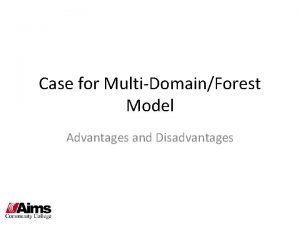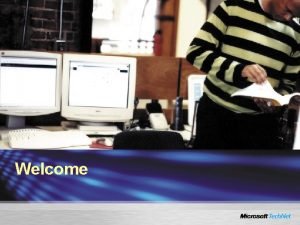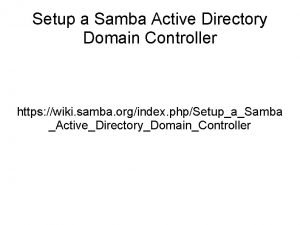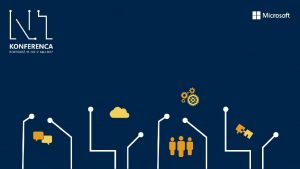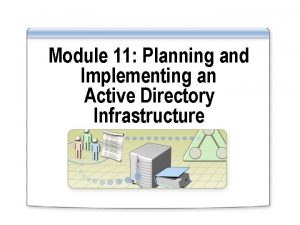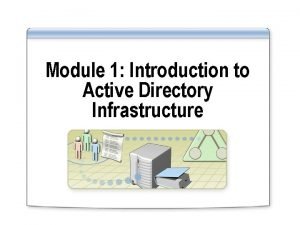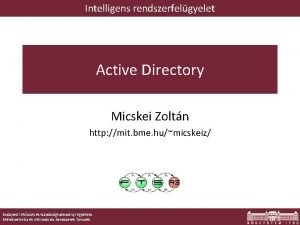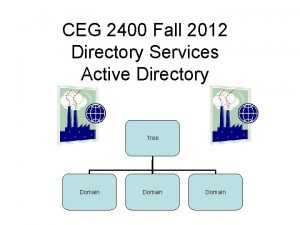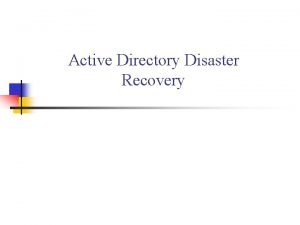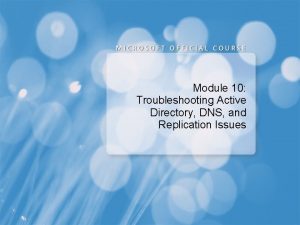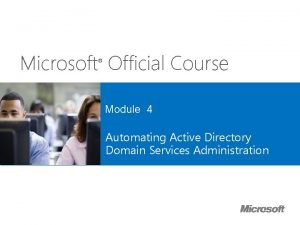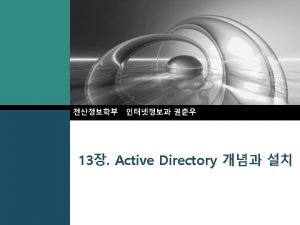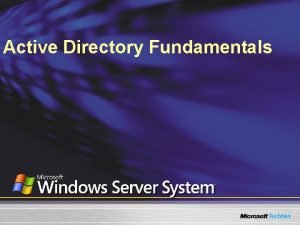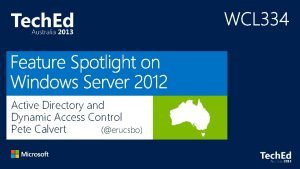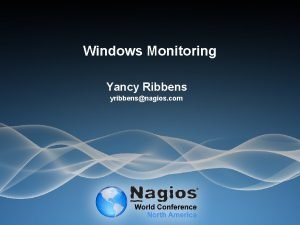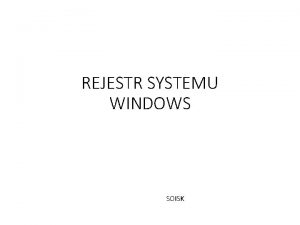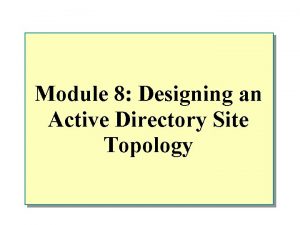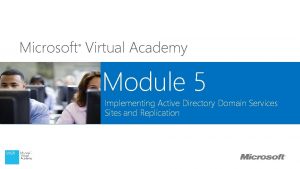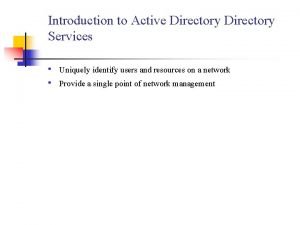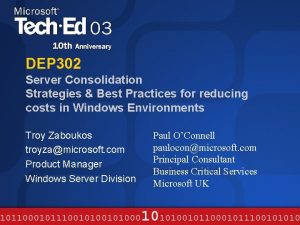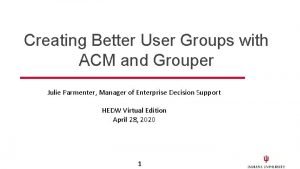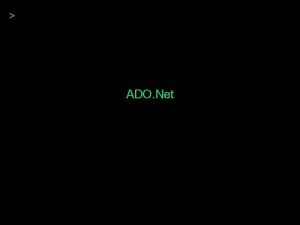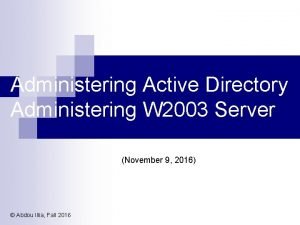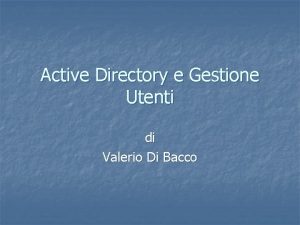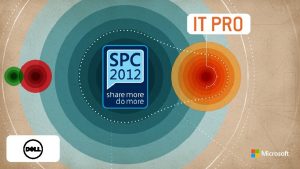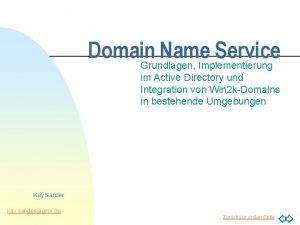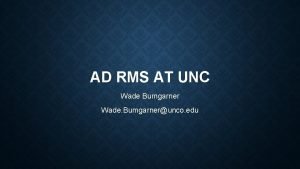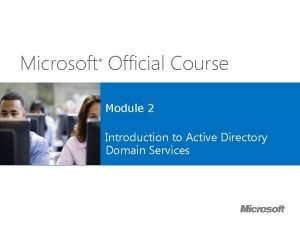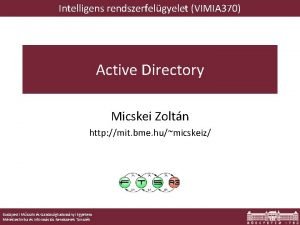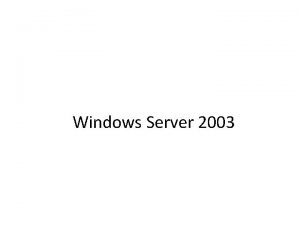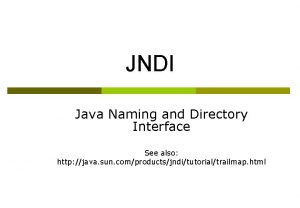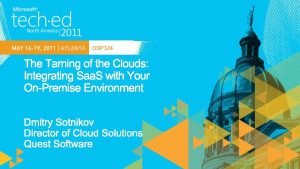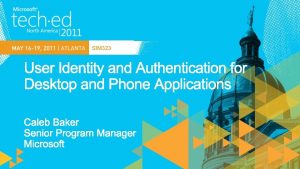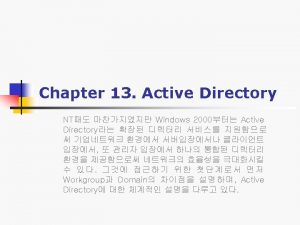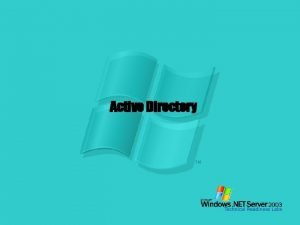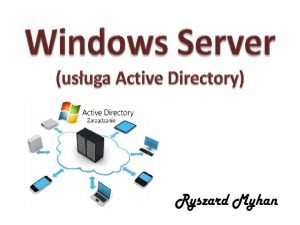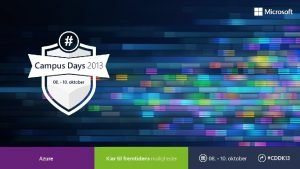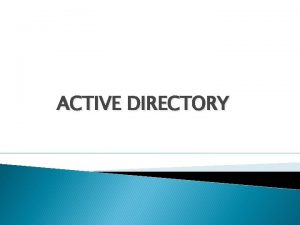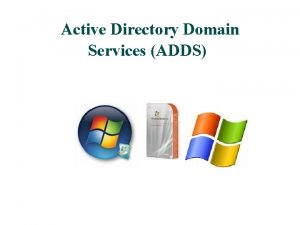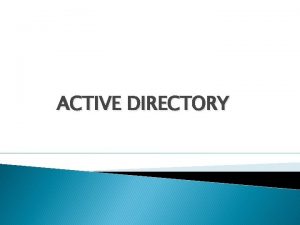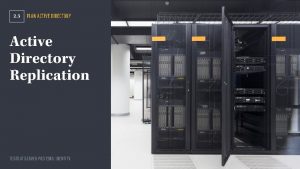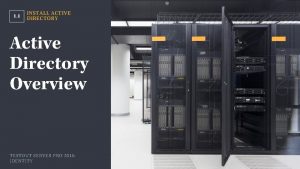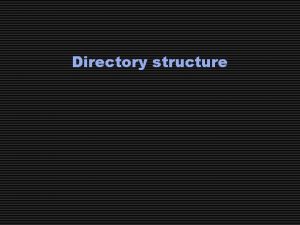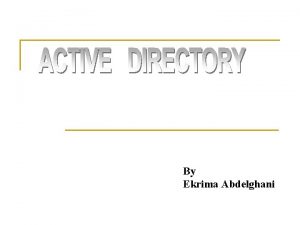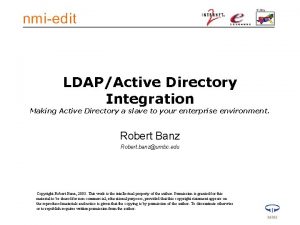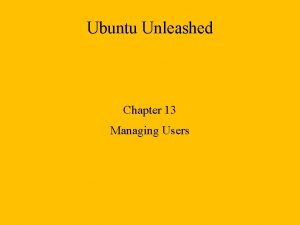Creating and Managing Active Directory Users and Computers




































- Slides: 36

Creating and Managing Active Directory Users and Computers Instructor: Ismail Rashid Email: Ismail. Rashid 2019@gmail. com

Recap of Previous lecture Active Directory Functions Authentication Authorization Active directory Architecture Classes of objects Container objects Leaf Objects Domain trees Replication Single master Multiple master Read only domain controllers (RODCs) Sites Bakhtar University 2

Overview • Create and Manage Active Directory Users and Computers o Creating User Objects o Creating Computer Objects o Managing Active Directory Objects Bakhtar University 3

Creating User Objects Bakhtar University 4

Creating User Objects • The user account is the primary method for authentication on a network. • Usernames and passwords are validated at log on by comparing entered information to the information stored in the AD DS database. Bakhtar University 5

Types of Users • Local users: These accounts can only access resources on the local computer and are stored in the local Security Account Manager (SAM) database on the computer where they reside. • Domain users: These accounts can access AD DS or network-based resources, such as shared folders and printers. o Account information for these users is stored in the AD DS database and replicated to all domain controllers within the same domain. Bakhtar University 6

Built-In User Accounts Administrator and Guest • On a member server or standalone server: The built-in local Administrator account has full control of all files as well as complete management permissions for the local computer. • On a domain controller: The built-in Administrator account created in Active Directory has full control of the domain in which it was created. The Administrator account cannot be deleted, but it can be renamed. Bakhtar University 7

Administrator Account Security Guidelines • Rename the Administrator account • Set a strong password • Limit knowledge of administrator passwords to only a few people • Do not use the Administrator account for daily non-administrative tasks Bakhtar University 8

Guest Account • This built-in account is used to provide temporary access to the network for a user such as a vendor representative or a temporary employee. • It cannot be deleted, but it can and should be renamed. • This account is disabled by default and is not assigned a default password. Bakhtar University 9

Create a User with Active Directory Administrative Center The Active Directory Administrative Center console Bakhtar University 10

Create a User with Active Directory Administrative Center A container in the Active Directory Administrative Center console Bakhtar University 11

Create a User with Active Directory Administrative Center The Create User window in the Active Directory Administrative Center console Bakhtar University 12

Create a User with Active Directory Users and Computers The Active Directory Users and Computers console Bakhtar University 13

Create a User with Active Directory Users and Computers The New Object - User Wizard Bakhtar University 14

Create a User with Active Directory Users and Computers The second page of the New Object - User Wizard Bakhtar University 15

User Templates • A user template is a standard user object containing common attribute settings. • To create a new user with these settings, you copy the template to a new user object and change the name. • You can change any attributes that are different. Bakhtar University 16

Create a User Template A user object’s Properties sheet Bakhtar University 17

Create a User Template The Copy Object – User Wizard Bakhtar University 18

Creating Computer Objects Lesson 14: Creating and Managing Active Directory Users and Computers Bakhtar University 19

Computer Objects • Consist of properties that specify the computer’s name, where it is located, and who is permitted to manage it. • Inherit group policy settings from container objects such as domains, sites, and organizational units. • Can be members of groups and inherit permissions from group objects. Bakhtar University 20

Adding a Computer to a Domain • Creating a computer account: Create a new computer object in Active Directory and assign the name of an actual computer on the network. • Joining the computer to the domain: The system contacts a domain controller, establishes a trust relationship with the domain, locates (or creates) a computer object corresponding to the computer’s name, alters its security identifier (SID) to match that of the computer object, and modifies its group memberships. Bakhtar University 21

Adding a Computer to a Domain Two ways to create AD computer objects: • Create the computer objects in advance using an Active Directory tool, so that the computers can locate the existing objects when they join the domain. • Begin the joining process first and let the computer create its own computer object. Bakhtar University 22

Creating Computer Objects Using Active Directory Users and Computers The New Object – Computer wizard Bakhtar University 23

Creating Computer Objects with Active Directory Administrative Center The Create Computer dialog box Bakhtar University 24

Managing Active Directory Objects Lesson 14: Creating and Managing Active Directory Users and Computers Bakhtar University 25

Managing Active Directory Objects A user object’s Properties sheet in Active Directory Administrative Center Bakhtar University 26

Managing Active Directory Objects A user object’s Properties sheet in Active Directory Users and Computers Bakhtar University 27

Managing Multiple Users A Multiple Users Properties sheet in Active Directory Administrative Center Bakhtar University 28

Joining Computers to a Domain The Computer Name tab in the System Properties dialog box Bakhtar University 29

Joining Computers to a Domain The Computer Name Changes dialog box Bakhtar University 30

Joining a Domain Using Netdom. exe netdom join <computername> /Domain: <Domain. Name> [/User. D: <User> /Password. D: <User. Password>] [/OU: OUDN] Bakhtar University 31

Creating Computer Objects while Joining • Domain users can also create computer objects themselves through an indirect process. • The Default Domain Controllers Policy GPO grants a user right called Add Workstations To The Domain to the Authenticated Users special identity. • Any user successfully authenticated to Active Directory is permitted to join up to ten workstations to the domain, and create ten associated computer objects. Bakhtar University 32

Creating Computer Objects while Joining The Default Domain Controllers Policy user rights assignments Bakhtar University 33

Joining a Domain while Offline • Use Djoin. exe program twice: 1. On a computer with access to a domain controller 2. On the computer to be joined. • The syntax for phase 1 of the process: djoin /provision /domain <domain name> /machine <computer name> /savefile <filename. txt> • You then transport the metadata file to the computer to be joined and run Djoin. exe again. • The syntax for the phase 2 of the process: djoin /request. ODJ /loadfile <filename. txt> /windowspath %System. Root% /localos Bakhtar University 34

Managing Disabled Accounts • Disabling a user account prevents anyone from using it to log on to the domain until an administrator with the appropriate permissions enables it again. • You can disable user accounts manually. • It is also possible for a system to automatically disable them for security reasons. • It is a simple Disable/Enable option in the GUI interface. Bakhtar University 35

Managing Disabled Accounts To disable or enable a user or computer account with Windows Power. Shell, use the following cmdlet syntax: Disable-ADAccount –Identity <account name> Enable-ADAccount –Identity <account name> Bakhtar University 36
 Advantages and disadvantages of active directory
Advantages and disadvantages of active directory Discoverb
Discoverb Samba ad dc
Samba ad dc Kerberos silver ticket
Kerberos silver ticket How to setup a privileged access workstation
How to setup a privileged access workstation Active directory design document
Active directory design document Introduction to active directory
Introduction to active directory Exchange performance analyzer
Exchange performance analyzer Active directory alapok
Active directory alapok Active directory two way trust
Active directory two way trust Active directory disaster recovery best practices
Active directory disaster recovery best practices Active directory replication troubleshooting
Active directory replication troubleshooting Lab 5: manage active directory accounts (module 4)
Lab 5: manage active directory accounts (module 4) Active directory logo
Active directory logo Active directory fundamentals
Active directory fundamentals Active directory dynamic access control
Active directory dynamic access control Nagios active directory monitoring
Nagios active directory monitoring Rejestr systemu windows
Rejestr systemu windows Site topology
Site topology Microsoft virtual academy active directory
Microsoft virtual academy active directory Introduction to active directory
Introduction to active directory Active directory consolidation best practices
Active directory consolidation best practices Acm
Acm 3schools sql
3schools sql Administering active directory
Administering active directory Gestione utenti active directory
Gestione utenti active directory Active directory cleanup tools
Active directory cleanup tools Active directory
Active directory Active directory grundlagen
Active directory grundlagen Unc active directory
Unc active directory Controladores de domínio do active directory
Controladores de domínio do active directory Active directory alapok
Active directory alapok Active directory fundamentals
Active directory fundamentals Boolean operators
Boolean operators Primary active transport and secondary active transport
Primary active transport and secondary active transport Primary active transport vs secondary active transport
Primary active transport vs secondary active transport Java naming directory interface
Java naming directory interface
